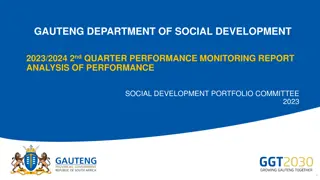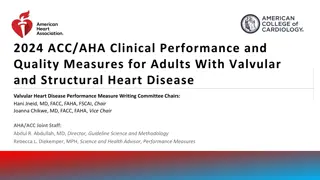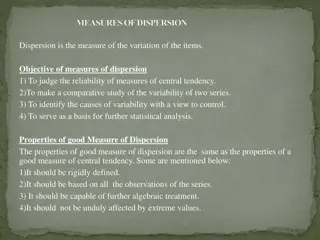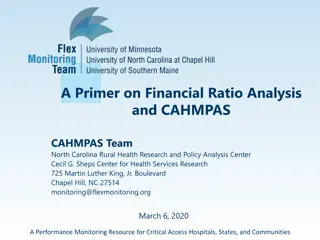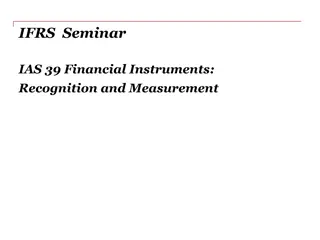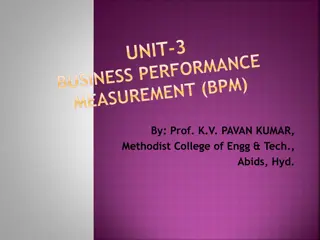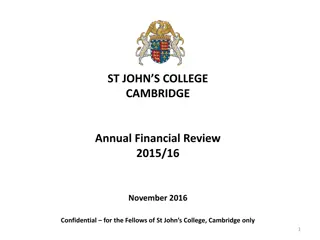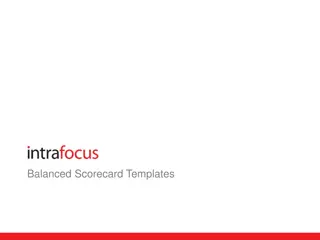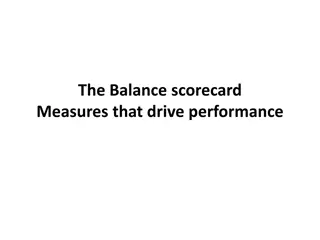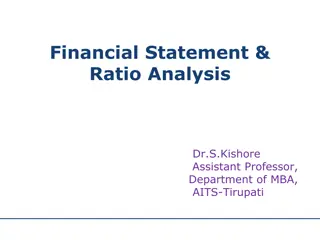Understanding Financial Performance Measures
Dive into the intricate world of measuring historical financial performance, exploring the interrelated aspects of equity infusion, cash flow systems, dividends paid, and debt servicing. Learn how the income statement, balance sheet, and cash flow statement play vital roles in financial statement analysis to evaluate company performance effectively.
Download Presentation

Please find below an Image/Link to download the presentation.
The content on the website is provided AS IS for your information and personal use only. It may not be sold, licensed, or shared on other websites without obtaining consent from the author. Download presentation by click this link. If you encounter any issues during the download, it is possible that the publisher has removed the file from their server.
E N D
Presentation Transcript
Measuring Historical Financial Measuring Historical Financial Performance Performance
Lets Start With Understanding the Financial System!
The Funds Flow System Equity Infusion Cash A Simple Cash Business Assets Profits Operations Operations Losses
Equity Infusion Dividends Paid Cash Purchase Expanding The Business Sale Inventories Receivables Assets Profits Operations Operations Sales Losses Taxes
Dividends Paid Equity Infusion Retained Cash Purchase Collections Inventories Sale Receivables Receivables Extending Credit Assets Profits Operations Operations Bad Debts Sales Losses Taxes
Dividends Paid Equity Infusion Retained Raising & Servicing Debt Cash Purchase Collections Trade Credit Inventories Sale Receivables Receivables Assets Debt Interest Profits Debt Service Operations Operations Bad Debts Sales Losses Taxes
Essentially a Financial System is Interrelated so Most Financial and Technical Indicators also Relate to Each Other
The Income Statement reflects the operating performance for the period i.e. production and sales which lead to either profit or losses. Income Statements need to be properly formatted for quick assessment. The Balance Sheet reflects the balance of the different accounts which are either assets, liabilities or equity. The balance sheet is a snapshot at any point in time. The Cash Flow Statement reflects the movement of cash during the year and is the bridge between the income statement and the balance sheet. The balance sheet is always reported at end or the reporting period while income and cash flow statements are for the entire reporting period usually a year. Financial Statement Analysis
Income Statement Good Format Poor Format Power Chemicals Maintenance Direct Labor Other direct Costs Revenues Operating Revenues Less: Power Less: Operating Expenses Chemicals Contribution Margin Labor Maintenance Less: General And Administrative Expenses Travel Gross Profit Before Interest, Depreciation & Other Non-Operating Income Transportation Interest Less: Interest Expense Depreciation Less: Depreciation Taxes Plus: Non Operating Income Provident Fund Profit Before Taxes Net Profit Less: Income Taxes Net Profit
Balance Sheet Poor Format Good Format ASSETS ASSETS Cash Cash Accounts Receivables Accounts Receivables Inventories Inventories Other Current Other Current Total Current Fixed Assets Land Total Assets Plant in Service LIABILITIES & EQUITY CWIP Accounts Payable Total Assets Other Payables LIABILITIES & EQUITY Current Portion of Long-Term Debt Accounts Payable Total Current liabilities Other Payables Long Term Debt Long Term Debt Total Liabilities Total Liabilities Equity Total Capital Paid in Capital Total Liabilities & Equity Retained Earnings Total Capital Total Liabilities & Equity
Cash Flow Good Format Poor Format Internal Cash Generation Fund Sources Net Income Before Interest Year-End Profits Add: Depreciation Depreciation Operating Cash Flow Reduction in Inventories Add: Beginning Cash Position Inventories Accounts Receivables Prepaid Expenses Accounts Payable Increase in Accounts Payables Changes in Working Capital (Inc./(Dec.) Loan Disbursements Cash Before Debt Service Add: Interest Charges Grants and Subsidies Principal Repayments Sale of Assets Total Debt Service Depreciation Expense Cash After Debt Service Total Sources of Cash Investment Operations Sale of Assets Fund Uses CAPEX Increase in Accounts Receivables Interest During Construction Increase in Prepaid Expenses Annual Capital Investments Capital Expenditures Cash After Investment Operations Interest During Construction Sources of Financing Principal Repayments Loans Total Uses of Cash Capital Grants Add: Beginning Balance Subsidies Cash Ending Balance Funds From Loans & Grants Cash Ending Balance
Financial Statement Analysis If you analyze the income statement and balance sheet but not the cash flow you are missing a big part of the analysis. That s because whatever is earned or expensed is nor necessarily converted to cash - Case in point receivables and payables. So first thing you have to figure out is whether the utility follows cash or accrual accounting. Assets use up cash while liabilities release cash. Ultimately if the business is cash starved it will go bankrupt if there is no external support.
About Diagnosing Performance of a Utility To be truly effective you need to understand the financial system of the utility and the interrelationship of the three main statements. Don t get bogged down with too many indicators. Performance Indicators and financial ratios are helpful but can lead you to the wrong conclusions and don t give you the full information. Benchmarking system can also be helpful but not all utilities are homogeneous. Their systems vary widely and also how investments are financed. Best benchmark for a utility is its own year-to-year variance, but careful if the utility on a fast growth curve. Closely study the Audit Report particularly the notes to the statements. Always Ask what s included in accounts you do not understand.
Components of Historical Diagnostic Demographic Overview System/Network Characteristics Characteristics of Consumer Base and Coverage Area Operating and Technical Performance Financial Performance Management, Institutional & Other Issues Summary of Debt Situation Sanitation and Wastewater Profile External Governance Profile Strategic Objectives Investment Priorities Action Items to Improve Performance Financing Requirements
Summary Data & Indicators Operating & Technical Performance Identify key operating performance in terms of water quality and service performance. Provide annual comparison for key operating indicators including: 2017 Water Produced Water Sold Service Connections Population Served Staff/Connection (000) Average Tariff Non Revenue Water Of which: commercial losses Operating Ratio Explanation of importance changes between the years 2016 2018
Summary Data & Indicators Financial Performance Identify key financial information and performance. Provide annual comparison for indicators including: 2016 2017 2018 Operating Results Operating Revenue Operating Expenses Interest Expense Depreciation Expense Net Income Operating Cash Flow Debt Payments Total Assets Current Assets Current Liabilities Working Capital Financial Indicators Collection Ratio Current Ratio Debt Service Coverage Ratio
NRW Operating Cost Coverage Ratio Collection Ratio Debt Service Coverage Ratio Net Profit Ratio Return on Fixed Assets Tariff Adequacy Key Performance Indicators
NRW is perhaps one of the more important indicators for water utilities as it measures both technical and commercial efficiency. High NRW levels may not necessarily lower operating costs substantially, particularly in gravity fed systems with low pumping costs, but for they may still greatly reduce investment efficiency if the entity is reaching its water resource capacity and requires new investments for developing a new water source. Analysis of the financial impacts of high NRW are necessary to develop appropriate remedial actions, if necessary. Non Revenue Water
NRW (in its simplest form) Water Produced 1- Water Billed
This is a key indicator for determining the entities overall revenue requirement and to what extent, that entity is recovering its operating and maintenance expenses. The ratio should be calculated strictly by comparing variable OPEX to Water and Sewerage Sales, also variable. Should not include depreciation, interest charges or general administrative expenses. Generally, a OCCR ratio or less than 1.0 means that any expansion in coverage will reduce the financial health of the entity, while a ratio of 1.5 and above will typically enhance it. In between these two points, there are opportunities for performance improvement and financing strategies that can bridge the financing gap by enhancing the financial health of the entities. Such opportunities need to be investigated with more thorough analysis to identify the financial impacts of improving performance of key indicators. Operating Cost Coverage Ratio (OCCR)
Operating Cost Coverage Ratio (OCCR) Operating Cost Coverage Ratio (OCCR) Capacity to crowd-in Commercial Finance Operating Revenues Operating Costs
The amount of revenue collected from water billed to customers can have substantial impact on the overall health of the WSP. In a sense, it has the same effects as Non-Revenue Water in reducing the financial health of the utility. Uncollected bills have the same effects as commercial water losses as they increase the revenue requirement and lower the OCCR. Low Collection ratios should be investigated by analyzing consumer accounts and by assessing and ageing analysis of outstanding receivables. The typical culprits in paying bills are other Government agencies and the military. High inflation can lead to overstatement of collections performance, particularly if using the collection period as ratio. Collection Ratio
Collection Ratios Collection Ratios Billed Subscriber Revenue Collections from Subscriber Accounts Receivables Balance X 365 Sales Revenue
The DSCR provides added information on the entitys capacity to borrow as it measures the service debt after O&M and working capital requirements are met. Most certainly, WSPs with OCCRs at 1.0 or below will not be even able to satisfy increases in working capital for running the operation a phenomena that typically results in the entity delaying payments to its suppliers and increasing other liabilities beyond prudent levels. Lenders are particularly concerned with the DSCR but while it may be important from an historical perspective it is more indicative from a prospective perspective. Depending on the volatility of the operations a DSCR can be adequate between 1.1 and 1.2 over operating cash flow. But each lender has its own criteria based on past history of the entity and its own risk tolerance. Debt Service Coverage Ratio (DSCR)
Debt Service Coverage Ratio (DSCR) Operating Cash Flow Debt & Interest Payments Operating Cash Flow = Net Income Before Interest + Depreciation
The relationship of net income to total revenue is a good indicator for assessing the overall profitability of the entity. However, this ratio can also be misleading in event the entity follows accrual accounting principles and much of the billed revenue is uncollected. As such, key to a true assessment of profitability must consider the financial results on a cash basis whereby, only cash collections and non- cash items such as depreciation expenses are factored into the assessment. Net Profit Ratio
Net Profit Ratio Net Profits Total Revenues
Measures the return to assets that have been specifically commissioned to produce operating revenues and provides an indication of the efficiency of the WSS plant and equipment in generating revenues for the utility. Low returns may indicate that either the fixed assets are not fully utilized or that the system is overbuilt or that tariff are not appropriate levels. Low consumer consumption rates would also indicate an underutilized system and poor investment planning. Return on Fixed Assets
Take the Example of the Take the Example of the Gia Gia Lam Water Treatment Plant Lam Water Treatment Plant Capacity of 30,000 cubic meters a day, but High Overhead Costs, Additional Maintenance Expenses Increased Debt Service Requirements Low Return on Fixed Assets = Output limited to 5,000 to 10,000 cubic meters because of inadequate transmission network
Return on Fixed Assets Gross Profits Fixed Assets Gross Profits = Operating Revenues Operating Costs
Questions For Discussion Net Profit Margin of 20%, no significant increase in total operations but a negative operating cash flow. OCCR of 1.5, Net Profit Margin of 35% and DSCR of .9. What is your initial assessment if the utility shows the following indicators Net Profit Margin of 30%, No Debt and A Return on Fixed Assets of .01%. OCCR of 1.5, a Net Income Loss, but DSCR of 1.3.
Tariff Adequacy goes beyond the simple concept of cost recovery tariffs since it assesses whether a tariff is justified assuming operational improvements. The importance of this concept cannot be overstressed because many WSPs with high inefficiency continually seek to request tariff increases to recover cost; but such costs can also include high inefficiencies. Policy makers and oversight agencies will typically accommodate these requests to reduce their requirement for operational subsidy payments, but the customer is essentially being overcharged. Customers find themselves not only paying for legitimate expenses, but also for such inefficiencies. A proper assessment of the adequacy of the tariff can then yield important information on whether the entity can significantly improve its overall financial health by simply correcting the performance levels. Tariff Adequacy
Tariff Adequacy Analysis An Example Following a recast of performance indicators, the $.37/m3 is more than adequate. Which indicator provides additional basis for the justified tariff?
Generally, creditworthiness measures the capacity of a borrower to fulfill all its financial obligations, including debt repayment. Creditworthiness is a valuation performed by lenders to determine the possibility a borrower may default on his debt obligations. A creditworthy borrower is one that can demonstrate long term financial strength and ability to pay its financial obligations in full and on time. What About Creditworthiness? So how do you determine long term financial strength and is the creditworthiness test a relative or absolute assessment?





